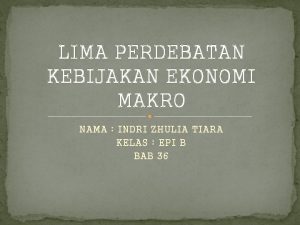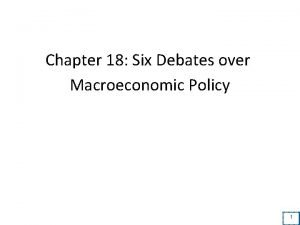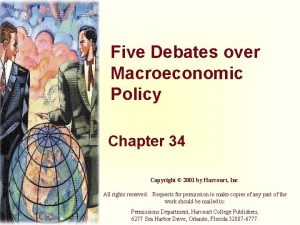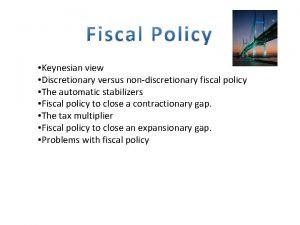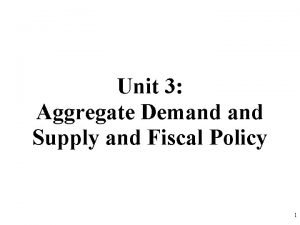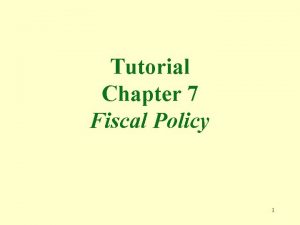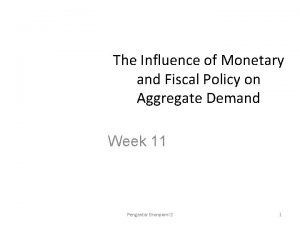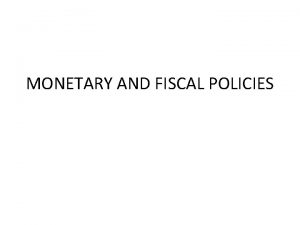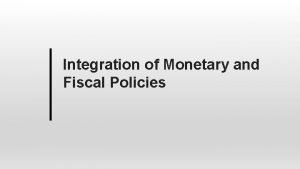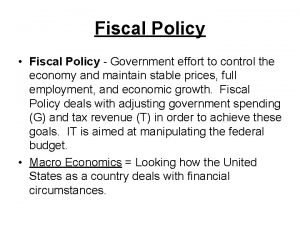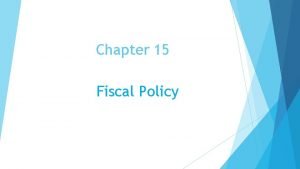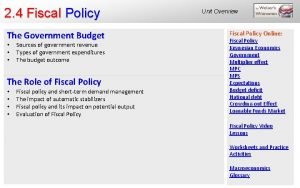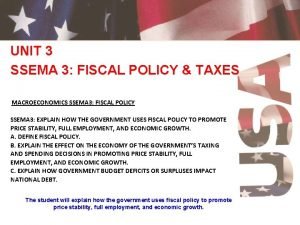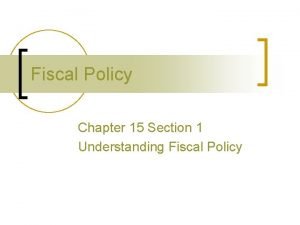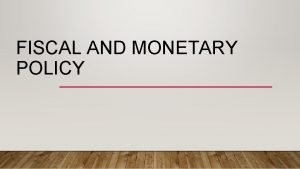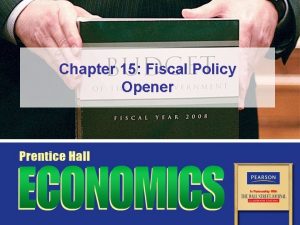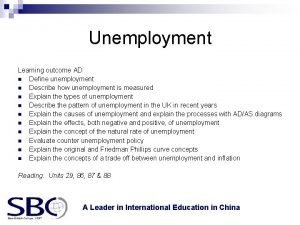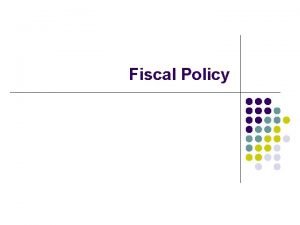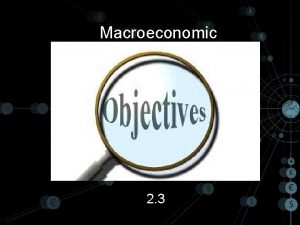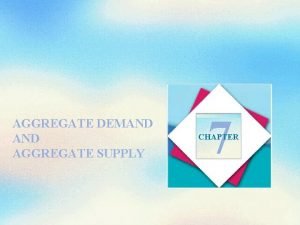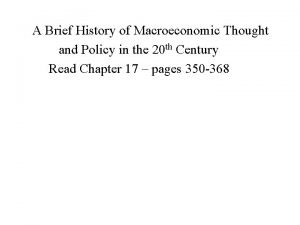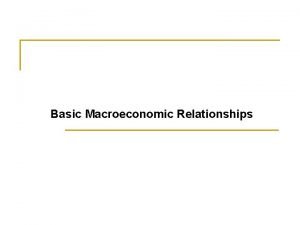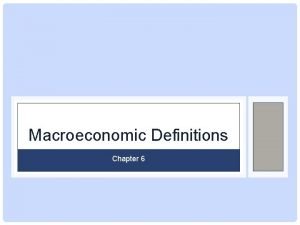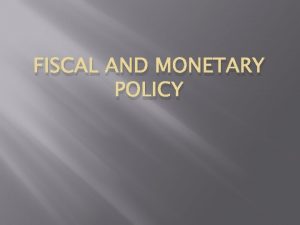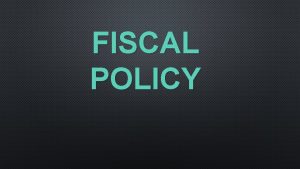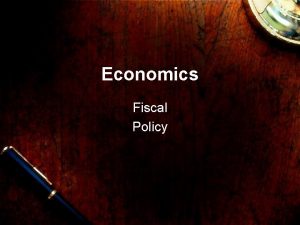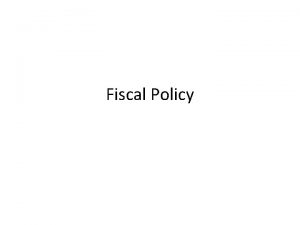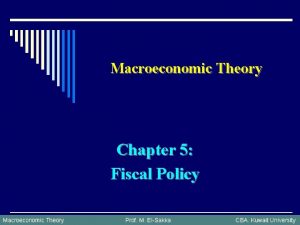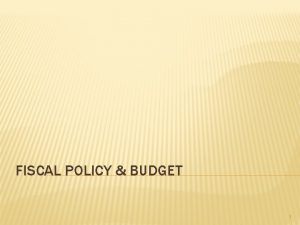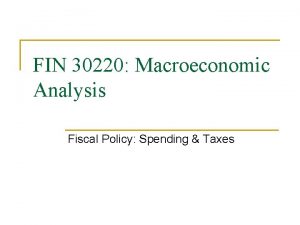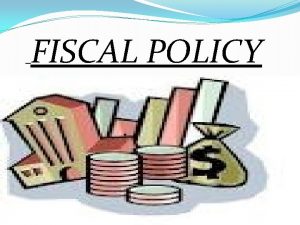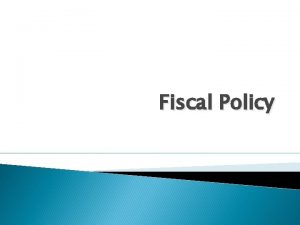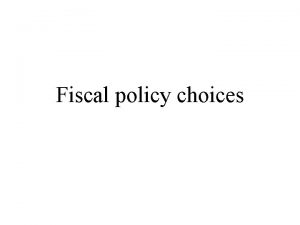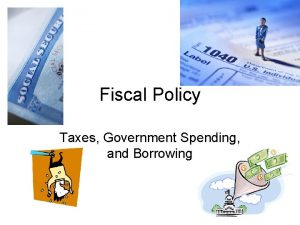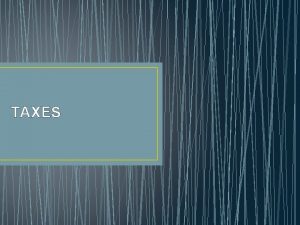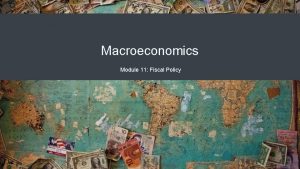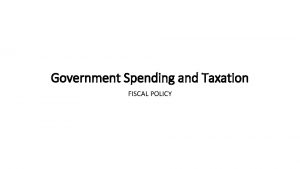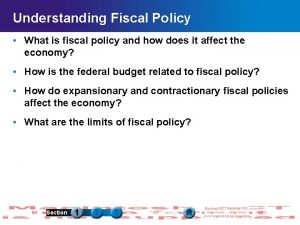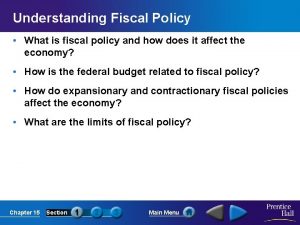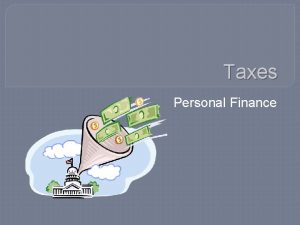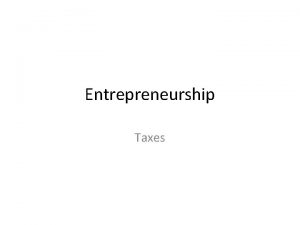Taxes Fiscal Policy and Macroeconomic Concepts TAXES Our
















































- Slides: 48

Taxes, Fiscal Policy, and Macroeconomic Concepts

TAXES � “Our new Constitution is now established, and has an appearance that promises permanency; but in the world nothing can be said to be certain except death and taxes. ” – Ben Franklin

What are taxes? � Tax Required payment to a local, state, or national government › Primary source of revenue for government � Two limitations › Common defense and general welfare › Federal taxes must be the same in every state

Tax bases and tax structures � Tax base income, property, good, or service that is subject to tax › Individual or corporate Income tax, sales tax, property tax � Proportional taxes % of income remains the same for all income levels › Ex. “Flat tax” 15% � Progressive taxes % of income paid in taxes increases as income increases › Ex. Income Tax � Regressive taxes % of income paid in taxes decreases as income increases › Ex. Sales Tax

Characteristics of a Tax � 4 characteristics › Simple, efficient, certain, fair � Benefits-received principle › People pay based on level of benefit � Ability-to-pay › Pay according to ability � Tax Incidence › If a product is inelastic, a tax will be paid by the consumer › If a product is elastic, a tax will be paid by the producer �Eventually paid by workers

Six types of taxes � Individual income tax � Corporate income tax � Social insurance tax � Excise tax � Estate and gift taxes � Import tax

� Individual and Corporate Income Tax Individual Amount each person owes to the federal government each year › 45% of government revenue › Corporate less than 10% › Pay-as-you-earn �Pay weekly/monthly from check � Employers withhold money from your pay › Estimate of how much you will owe the government � Tax return form used to file income taxes › Deductions and exemptions › May owe the government, or they may owe you � Income tax is progressive tax brackets › Rate schedule published each year

Taxable income is between The tax is: $0 - $9, 275 10% $9, 276 - $37, 650 15% $37, 651 - $91, 150 25% $91, 151 - $190, 150 28% $190, 151 - $413, 350 33% $413, 351 – $415, 050 35% $415, 051 or greater 39. 6%

Social insurance taxes � FICA taxes that fund Social Security and Medicare › Majority to Social Security › $780 billion annually � Social security benefits to people over 65 and disabled � Medicare national health insurance program for people over 65 and disabled � Unemployment tax › Paid for by employer

Other taxes � Excise Tax general revenue tax on the sale or manufacture of a good � Estate Tax tax on the estate or value of money and property of a person who had died › Less than $1. 5 mil not taxed � Gift Tax Keep people from avoided estate tax � Import Tax on imported goods (Tariff) � Tax incentive Tax on goods to discourage purchase


Government Spending



Types of spending � Mandatory Spending › Money that is required by law to be spent on certain programs & interest on debt › Most goes to “entitlement programs” �Continue to rise �Ex. Social Security and Medicare � Discretionary Spending › Spending that government planners can make choices on its use �Ex. Defense and Education




Discretionary Spending � Defense spending dropped since Cold War (20%) › Troops and civilian workers � Everything else › Education › Scientific research › Student loans › Technology › National Parks › Housing › Environment clean-up › Disaster relief › Foreign aid


Defense spending


Federal Aid to State and Local Governments � State and federal governments share costs of: › some social programs › highway construction › Education › housing,

� State Government Revenue and Spending Money from federal and local governments are main source of revenue for state government › Sales tax and Individual income taxes also large contributor › The Georgia (GA) state sales tax rate is currently 4. 0%. Depending on local municipalities, the total tax rate can be as high as 8%. › No federal sales tax � Where the money goes: › Education (majority), Public Safety, Highways, Public welfare, Arts and recreation, Administration

State Budgets � Operating Budget for day-to-day expenses �Salaries for state employees, office supplies, maintenance � Capital Budget for major capital, or investment › New facilities, highways › Borrowing � All states but Alaska require a balanced budget › Take in as much as they spend › Revenue = Spending


Local Government revenue and spending � Local governments earn revenue from federal and state governments › Also collect from property taxes to pay for schools and road construction and maintenance � Local governments pay for: › Public schools (majority), Law enforcement and fire protection, Libraries, airports, hospitals, Parks and beaches, Public health & transportation, Elections

Fiscal Policy

Classical Economics � Classical Economics free markets can regulate themselves › Adam Smith, Friedrich Hayek, Thomas Malthus � Challenged by the Great Depression › Prices fell demand fell � Classical economics didn’t address length of time for market to reach equilibrium � Led to new thinking Keynesian Economics

Keynesian Economics � John Maynard Keynes (pronounced Canes) � Demand-side economics government spending and tax cuts help an economy by raising demand � Keynesian Economics demand-side economics that encourages government action to change demand output

New Role for Government � Three parts to an economy › Business, consumers, and government � If consumers and businesses aren’t spending, then the third part needs to spend (government) � Government spending encourage production increase employment spend wages more production › Continuous cycle › Government would eventually reduce spending

Epic Rap Battle of Economics VS Friedrich Hayek John Maynard Keynes


Supply-Side Economics � Supply-side economics tax cuts can help the economy by raising supply � Laffer Curve shows effects of taxes › Governments earn no revenue with 0% or 100% taxation � Reducing taxes may encourage workers to work more and may bring in more revenue than with higher taxes




Fiscal Policy � Fiscal Policy use of government spending and revenue (taxing) to influence the economy � Government spends about $400 million per hour, and $3. 5 trillion (2013) � Reasons for spending: › Stimulate demand, increase production, create jobs, increase GDP, avoid recessions, control inflation, stabilize economic growth

Federal Budget � Federal Budget plan for federal government’s spending and revenues for a year › Fiscal year October 1 – Sept. 30 � Office of Management and Budget (OMB) manages federal budget � Appropriations bills bill that sets money aside for specific spending › President can sign or veto

Expansionary Fiscal Policies � Expansionary policies encourage economic growth › Higher spending and tax cuts � Spending › Buy more goods and services cause prices to rise increases production creates jobs � Lower Taxes › Individuals have more money to spend businesses earn more profit more $ to invest in capital create jobs

Contractionary Fiscal Policies � Contractionary Fiscal Policies Reduce economic growth › Less Spending and higher taxes › Goal is to decrease inflation � Less Spending › Decrease in spending decrease in demand lower prices less production lay off workers � Higher taxes › Individuals have less money to spend prices fall and firms have less to spend on capital less jobs


Budget Deficit and National Debt

Federal Budget � Raising government spending can lead to budget deficits which add to the national debt › Deficit amount of $ the government borrows in a year › Debt sum of deficits from previous years � Balanced Budget Revenue equals spending � Budget Surplus Revenue more than spending � Budget Deficit Revenue less than spending


Problems of National Debt � Reduces funds available for businesses to invest › High interest rates � Government spending on interest on debt is less money that can be spent elsewhere


 Macroeconomic policy debates
Macroeconomic policy debates Perdebatan kebijakan makro ekonomi
Perdebatan kebijakan makro ekonomi Six debates over macroeconomic policy
Six debates over macroeconomic policy 5 debates over macroeconomic policy
5 debates over macroeconomic policy Five debates over macroeconomic policy
Five debates over macroeconomic policy Monetary and fiscal policy interactions activity 5-5
Monetary and fiscal policy interactions activity 5-5 Unit 3 aggregate demand aggregate supply and fiscal policy
Unit 3 aggregate demand aggregate supply and fiscal policy Unit 3 aggregate demand aggregate supply and fiscal policy
Unit 3 aggregate demand aggregate supply and fiscal policy Discretionary and non discretionary fiscal policy
Discretionary and non discretionary fiscal policy Unit 3 aggregate demand aggregate supply and fiscal policy
Unit 3 aggregate demand aggregate supply and fiscal policy Galloping inflation
Galloping inflation Example fiscal policy
Example fiscal policy Fiscal policy practice
Fiscal policy practice Components of fiscal policy
Components of fiscal policy Crowding out effect of fiscal policy
Crowding out effect of fiscal policy What is liquidity ratio in banking
What is liquidity ratio in banking Instruments of fiscal policy
Instruments of fiscal policy Fiscal policy ib
Fiscal policy ib Fiscal demand side policy
Fiscal demand side policy Fiscal policy definition
Fiscal policy definition Contractionary fiscal policy
Contractionary fiscal policy Instruments of fiscal policy
Instruments of fiscal policy Crowding out effect of fiscal policy
Crowding out effect of fiscal policy Demand side fiscal policy definition
Demand side fiscal policy definition Contractionary fiscal policy interest rate
Contractionary fiscal policy interest rate Crowding out effect of fiscal policy
Crowding out effect of fiscal policy Example of expansionary fiscal policy
Example of expansionary fiscal policy Fiscal policy
Fiscal policy Goals of fiscal policy
Goals of fiscal policy Fiscal vs monetary policy
Fiscal vs monetary policy Goals of fiscal policy
Goals of fiscal policy Fiscal policy
Fiscal policy Unemployment
Unemployment Definition of fiscal policy
Definition of fiscal policy Conclusion of monetary policy
Conclusion of monetary policy Fiscal policy definition
Fiscal policy definition Meaning
Meaning Macroeconomic and industry analysis
Macroeconomic and industry analysis Macroeconomic objectives
Macroeconomic objectives Macroeconomic equilibrium occurs:
Macroeconomic equilibrium occurs: Macroeconomics deals with?
Macroeconomics deals with? History of macroeconomic thought
History of macroeconomic thought A macroeconomic theory of the open economy
A macroeconomic theory of the open economy Basic macroeconomic relationships
Basic macroeconomic relationships Macroeconomic definitions
Macroeconomic definitions Awareness of ourselves and our environment is
Awareness of ourselves and our environment is Is our awareness of ourselves and our environment.
Is our awareness of ourselves and our environment. Awareness of ourselves and our environment is
Awareness of ourselves and our environment is Our awareness of ourselves and our environment.
Our awareness of ourselves and our environment.

